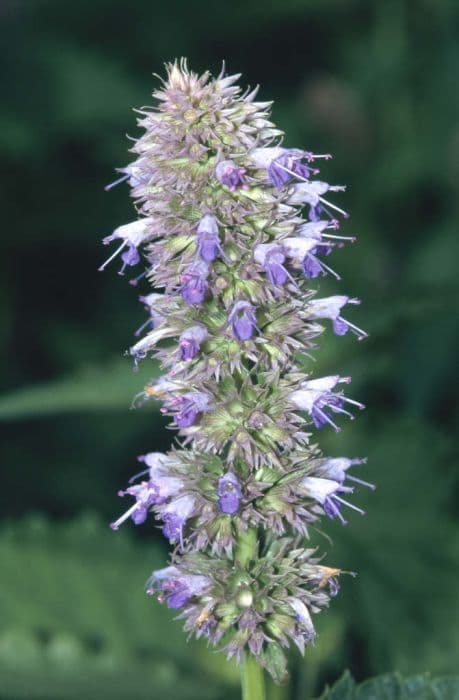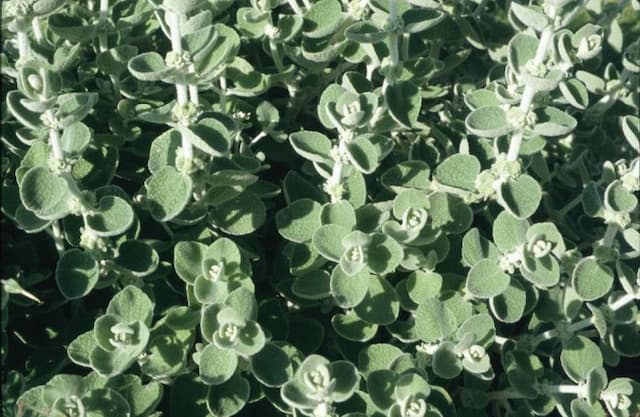Woodland Sage Salvia nemorosa Blue Bouquetta = 'Alkif'
![Balkan clary [Blue Bouquetta]](/_next/image?url=https%3A%2F%2Fplants-admin.emdemapps.com%2Fimages%2Fplants%2F%2Fimages%2F604b640a898d9.png&w=3840&q=75)
ABOUT
Salvia nemorosa Blue Bouquetta, commonly known as Woodland Sage, features a striking appearance with vibrant blue flowers that are highly attractive to both garden enthusiasts and pollinators like bees and butterflies. The flowers are neatly arranged in dense, elongated spikes that rise elegantly above the foliage. The plant's leaves are typically a fresh green color, providing a lovely contrast to the rich blue of the blooms. These leaves are often characterized by a slightly wrinkled texture and a lance-shaped form, which can add to the textural interest of the plant in a garden setting. The overall form of Woodland Sage is upright and clumping, creating a visually appealing structure that works well in mixed borders or as a focal point in a garden bed. The color and form of the Woodland Sage make it a popular choice for gardeners looking to add a touch of cool-toned elegance to their outdoor spaces.
About this plant
 Names
NamesFamily
Lamiaceae
Synonyms
Woodland Sage, Balkan Clary
Common names
Salvia nemorosa 'Alkif'
 Toxicity
ToxicityTo humans
The Salvia nemorosa, also known as Woodland Sage, generally has low toxicity to humans. Most species of Salvia are not known to be poisonous if ingested. However, it is always best to avoid consuming any plant material unless it is known to be safe for consumption, as individual reactions can vary due to allergies or sensitivities. Common garden Salvias are not typically associated with severe toxicity, but consuming large quantities might cause mild gastrointestinal upset in some individuals.
To pets
Woodland Sage is also considered to have low toxicity to pets. It is not commonly listed as a toxic plant to cats, dogs, or other domestic animals. If a pet were to ingest a small amount of Woodland Sage, it is unlikely to cause more than mild gastrointestinal discomfort. However, as with any non-food plant, it's wise to prevent pets from ingesting it because individual animals may have different sensitivities or allergic reactions.
 Characteristics
CharacteristicsLife cycle
Perennials
Foliage type
Deciduous
Color of leaves
Green
Flower color
Blue
Height
1-2 feet (30-60 cm)
Spread
1-2 feet (30-60 cm)
Plant type
Herb
Hardiness zones
4
Native area
Europe
Benefits
 General Benefits
General Benefits- Aesthetic Appeal: 'Alkif' adds a splash of color with its vibrant blue flowers, enhancing the visual appeal of gardens and landscapes.
- Attracts Pollinators: The plant is known for attracting bees, butterflies, and other beneficial insects, supporting biodiversity.
- Drought Tolerance: Once established, 'Alkif' has good drought tolerance, making it suitable for xeriscaping and low-water gardens.
- Easy Maintenance: It is generally low-maintenance, requiring minimal care once established, ideal for beginner gardeners.
- Long Blooming Period: With a long flowering time, 'Alkif' provides a lengthy display of blooms throughout the growing season.
- Deer and Rabbit Resistance: The plant is not favored by deer and rabbits, reducing the likelihood of damage from these animals.
- Cold Hardy: 'Alkif' is tolerant of cold temperatures, making it suitable for planting in a variety of climates.
- Compact Growth: Its compact growth habit makes it suitable for small gardens, borders, and container planting.
 Medical Properties
Medical PropertiesThis plant is not used for medical purposes.
 Air-purifying Qualities
Air-purifying QualitiesThis plant is not specifically known for air purifying qualities.
 Other Uses
Other Uses- As a natural fabric dye: The leaves of Salvia nemorosa can be used to produce a range of green shades on textiles.
- In beekeeping: Because of its attractiveness to bees, it can be planted around bee hives to support honey production.
- Garden design: It's used to create a "river effect" by planting multiple Salvia nemorosa in a flowing, serpentine pattern in the landscape.
- Companion planting: This plant can be used in vegetable gardens to attract pollinators to crops and enhance pollination.
- In crafting: The dried flowers of Salvia nemorosa are used in potpourri mixes.
- As a floral ink: The pigment from the blossoms can be used to make a natural ink for art and calligraphy.
- For theme gardens: Salvia nemorosa fits well into moon gardens with its light-colored varieties opening blooms in the twilight hours.
- Education: This plant is a tool for botanical and horticultural studies, teaching about plant morphology and various cultivation needs.
- Cooking: Although not common, the flowers can be used in small quantities as a garnish for salads and desserts.
- Photography: Because of its striking bloom, Salvia nemorosa is often used as a subject in botanical photography.
Interesting Facts
 Feng Shui
Feng ShuiThe Meadow Sage is not used in Feng Shui practice.
 Zodiac Sign Compitability
Zodiac Sign CompitabilityThe Meadow Sage is not used in astrology practice.
 Plant Symbolism
Plant Symbolism- Wisdom - "Salvia" comes from the Latin "salvere," which means "to save" or "to heal," indicating a connection to wisdom, as well as healing properties often associated with some Salvia species.
- Longevity - Many salvias are perennials, meaning they live for more than two years, symbolizing enduring life and longevity.
- Protection - Salvias have been used in various cultures for their medicinal and protective qualities, symbolizing safety and preservation.
- Spiritual awakening - Salvias are sometimes associated with spiritual insight and the opening of the mind, reflecting a connection to a deeper understanding or spiritual awakening.
 Water
WaterFor the Woodland Sage, water the plant deeply and infrequently to encourage strong root development. Typically, watering once per week during the growing season is sufficient, providing about 1 inch of water each time. In terms of volume, this is roughly equivalent to 0.6 gallons per square foot of soil. If there has been a significant amount of rainfall, you can skip the watering for that week. During periods of extreme heat and drought, you may need to increase watering frequency, but always allow the soil to dry out slightly between waterings to prevent root rot.
 Light
LightThe Woodland Sage thrives best in full sun to partial shade. The optimal spot for this plant is where it can receive at least six hours of sunlight daily. It's adaptable to various light conditions but flowering is most prolific when the plant is given plenty of sun. Avoid deeply shaded areas as this can lead to sparse blooms and a leggy growth habit.
 Temperature
TemperatureWoodland Sage prefers temperatures between 60 and 70 degrees Fahrenheit for optimal growth. It can survive short periods of colder weather down to 20 degrees Fahrenheit and can tolerate summer highs up to the low 90s. The ideal temperature range should be maintained as much as possible to ensure the health and blooming of the plant.
 Pruning
PruningPruning Woodland Sage is essential for maintaining its shape and encouraging a second bloom. Deadhead spent flowers regularly throughout the blooming season to promote continuous flowering. After the initial flush of blooms, prune back the plant by about a third to encourage a fresh batch of flowers. The best time for a more substantial cut back is after the first killing frost or in early spring before new growth begins.
 Cleaning
CleaningAs needed
 Soil
SoilWoodland Sage prefers well-draining soil rich in organic matter with a pH ranging from 6.5 to 7.0. A mix incorporating garden soil, compost, perlite, and peat moss would be ideal to ensure good drainage and fertility.
 Repotting
RepottingWoodland Sage should be repotted every 2 to 3 years or when it outgrows its current container. Early spring is the best time to repot this perennial plant.
 Humidity & Misting
Humidity & MistingWoodland Sage tolerates a wide range of humidity levels but thrives best with moderate atmospheric humidity, typical of many temperate gardens.
 Suitable locations
Suitable locationsIndoor
Plant in well-draining soil, provide full sun to part shade, and moderate water.
Outdoor
Use well-draining soil, full sun exposure, and water regularly.
Hardiness zone
4-9 USDA
 Life cycle
Life cycleSalvia nemorosa 'Blue Bouquetta', commonly known as Sage or Woodland Sage, begins its life cycle as a seed which germinates in spring when soil temperatures are consistently warm. The seedlings develop roots and shoots, and once established, foliage begins to grow in a rosette form. As the plant matures, it enters the vegetative stage, producing strong stems and vibrant green leaves, preparing for the flowering phase. Flowering typically occurs in late spring to early summer, displaying dense spikes of small, attractive blue to violet flowers which attract pollinators such as bees and butterflies. After pollination, seeds develop and are eventually dispersed, completing the reproductive cycle. In temperate climates, Salvia nemorosa 'Blue Bouquetta' may die back to the ground in the winter, but as a perennial, the root system survives and the plant regrows the following spring, repeating its life cycle.
 Propogation
PropogationPropogation time
Spring to early summer
Propogation: Salvia nemorosa 'Blue Bouquetta' is commonly propagated via stem cuttings, a method that encourages the development of a new plant identical to the parent plant. For best results, this should be done in late spring or early summer when the plant's growth is most vigorous. A healthy, non-flowering stem should be selected and cut just below a node, using sharp, clean scissors or pruners. The cutting should be about 2-4 inches (5-10 cm) in length and the lower leaves should be removed. The base of the cutting can be dipped in a rooting hormone to increase the chances of successful rooting. Afterwards, the cutting should be placed in a well-draining potting mix, ensuring the node where the lower leaves were removed is buried. The pot should be kept in a warm, humid environment out of direct sunlight, and the soil should be kept moist but not waterlogged until roots have developed and new growth is apparent.









